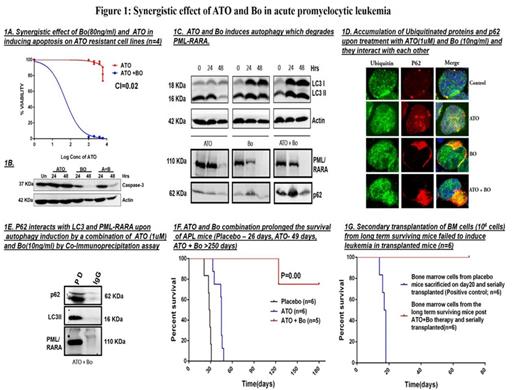Abstract
Degradation of PML-RARA upon treatment with ATO is predominantly mediated by the proteasome complex. Reports suggest that in relapsed APL patients who were treated upfront with ATO, mutations in the B2 domain of PML in PML-RARA gene are involved in resistance to ATO. These mutations predict a poor clinical outcome in spite of subsequent combination of ATO with chemotherapy (NEJM 2014). We had previously reported that Bortezomib (Bo) was able to synergize with ATO by inducing apoptosis through increased levels of ROS and up regulation of the UPR pathway (Blood. 2012;120, 3552) and we had also noted PML-RARA degradation and nuclear body formation with this combination. We further evaluated the mechanism of degradation of PML-RARA when ATO was combined with Bo and the effect of this combination on resistant cell lines, a mouse model and in relapsed patients.
We generated in-house ATO resistant NB4 cell lines (NB4EV-ASR1, ASR2 and ASR3). In NB4EV-ASR1 we confirmed the presence of A216V mutation in the PML B2 domain (previously reported to be involved in ATO resistance) while the other 2 clones did not have this or any other mutation in PML-RARA. We noted an increase in the baseline proteasomal activity in all the resistant cell lines when compared to naïve NB4 cells (n=3; data not shown). The combination of ATO and Bo induced a significant apoptosis in all the resistant cells similar to naïve NB4 cells (Figure 1A: n=4; Combination Index = 0.02).The mechanism of inducing apoptosis in the resistant cell lines was similar to naïve NB4 cells, as previously reported by us, and involved an increased level of ROS, decreased mitochondrial membrane potential, induction of UPR and activation of caspase-3 (Figure 1B).
We next evaluated PML-RARA degradation in NB4 naive cells treated with a combination of ATO+Bo. At 24 hours, there was an evidence of induction in autophagy as shown by LC3II formation using western blot technique which increased at 48 hours; this time point coincides with time at which maximum PML-RARA degradation occurred (Figure1C). Similar results were seen in the resistant cell lines (with and without mutation A216V). Blocking autophagy by 3-methyl adenine showed a partial inhibition in the degradation of PML-RARA. We have also observed that there is an accumulation of p62 (ubiquitin binding protein) at 24 hours and this was degraded by 48 hours suggests that accumulated ubiquitinated products were cleared by autophagy via p62 (Figure1D). In a co-immunoprecipitation experiment, p62 and LC3II proteins precipitated along with PML-RARA (figure 1E). Knock down of p62 transcript by siRNA followed by ATO+Bo treatment showed an accumulation of PML-RARA in the treated cells in comparison to the scrambled and control.
In an APL transplanted mice model, combination of ATO and Bo prolonged the life span of the mice as illustrated in Figure1F. In this group there was a significant decrease in the leukemia burden evidenced by decreased leukemic cells in bone marrow, peripheral blood and spleen by flow cytometry, RQ-PCR and decreased spleen size on day +20. A reduction in the LIC was demonstrated by secondary transplants. We also observed that transplantation of bone marrow cells from the long term surviving mice post ATO+Bo therapy did not induce leukemia (Figure1G) and no transcripts of PML-RARA were detected in the recipients.
A phase II clinical study combining Bo with ATO and chemotherapy has been initiated for patients with relapsed APL (NCT01950611). In this ongoing study 11 patients have been enrolled. The median age was 32 years. 7 were males. All patients achieved hematological remission and the median time to complete molecular remission was 42 days (one patient still on induction therapy). The addition of Bo was well tolerated. None of the cases had evidence of significant neuropathy, worsening of coagulopathy, IC bleed or a differentiation syndrome. Long term follow up is awaited to comment on the efficacy of this combination.
In conclusion, the mechanism of ATO+Bo synergy is multi-factorial and appears to be predominantly due to increase in ROS activity and up regulation of UPR pathway leading to apoptosis. In spite of proteasomal inhibition by addition of Bo with ATO, PML-RARA continues to be degraded and this is mediated by up-regulation of autophagy pathway. ATO+Bo synergy was further confirmed in a pre-clinical model. This combination is also effective in ATO resistant cell lines with high levels of synergism.
Off Label Use: Bortezomib in the treatment of acute promyelocytic leukemia.
Author notes
Asterisk with author names denotes non-ASH members.


This feature is available to Subscribers Only
Sign In or Create an Account Close Modal